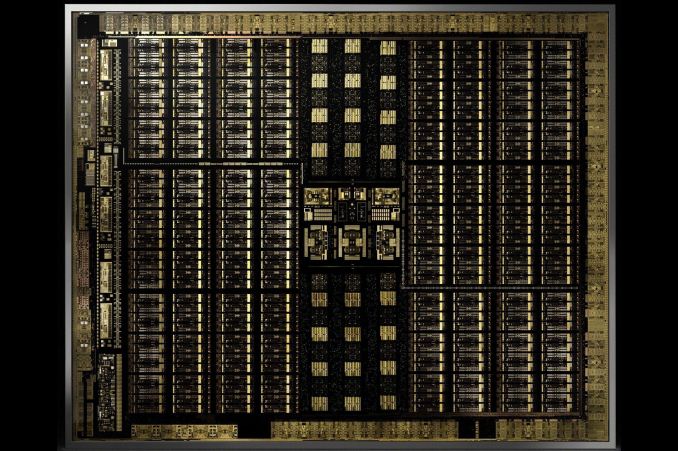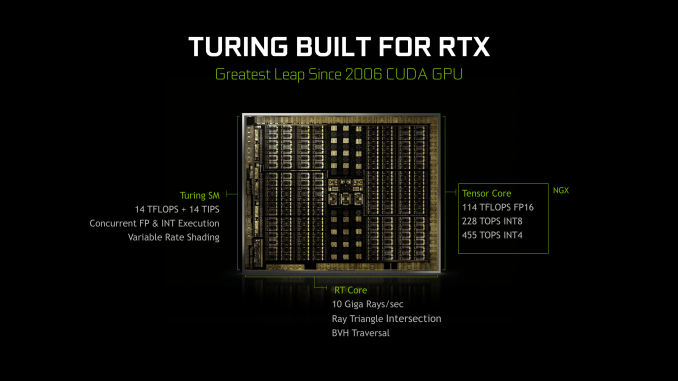The NVIDIA Turing GPU Architecture Deep Dive: Prelude to GeForce RTX
by Nate Oh on September 14, 2018 12:30 PM EST
It’s been roughly a month since NVIDIA's Turing architecture was revealed, and if the GeForce RTX 20-series announcement a few weeks ago has clued us in on anything, is that real time raytracing was important enough for NVIDIA to drop “GeForce GTX” for “GeForce RTX” and completely change the tenor of how they talk about gaming video cards. Since then, it’s become clear that Turing and the GeForce RTX 20-series have a lot of moving parts: RT Cores, real time raytracing, Tensor Cores, AI features (i.e. DLSS), raytracing APIs. All of it coming together for a future direction of both game development and GeForce cards.
In a significant departure from past launches, NVIDIA has broken up the embargos around the unveiling of their latest cards into two parts: architecture and performance. For the first part, today NVIDIA has finally lifted the veil on much of the Turing architecture details, and there are many. So many that there are some interesting aspects that have yet to be explained, and some that we’ll need to dig into alongside objective data. But it also gives us an opportunity to pick apart the namesake of GeForce RTX: raytracing.
While we can't discuss real-world performance until next week, for real time ray tracing it is almost a moot point. In short, there's no software to use with it right now. Accessing Turing's ray tracing features requires using the DirectX Raytracing (DXR) API, NVIDIA's OptiX engine, or the unreleased Vulkan ray tracing extensions. For use in video games, it essentially narrows down to just DXR, which has yet to be released to end-users.
The timing, however, is better than it seems. A year or so later could mean facing products that are competitive in traditional rasterization. And given NVIDIA's traditionally strong ecosystem with developers and middleware (e.g. GameWorks), they would want to leverage high-profile games for ringing up consumer support for hybrid rendering, which is where both ray tracing and rasterization is used.
So as we've said before, with hybrid rendering, NVIDIA is gunning for nothing less than a complete paradigm shift in consumer graphics and gaming GPUs. And insofar as real time ray tracing is the 'holy grail' of computer graphics, NVIDIA has plenty of other potential motivations beyond graphical purism. Like all high-performance silicon design firms, NVIDIA is feeling the pressure of the slow death of Moore's Law, of which fixed function but versatile hardware provides a solution. And where NVIDIA compares the Turing 20-series to the Pascal 10-series, Turing has much more in common with Volta, being in the same generational compute family (sm_75 and sm_70), an interesting development as both NVIDIA and AMD have stated that GPU architecture will soon diverge into separate designs for gaming and compute. Not to mention that making a new standard out of hybrid rendering would hamper competitors from either catching up or joining the market.
But real time ray tracing being what it is, it was always a matter of time before it became feasible, either through NVIDIA or another company. DXR, for its part, doesn't specify the implementations for running its hardware accelerated layer. What adds to the complexity is the branding and marketing of the Turing-related GeForce RTX ecosystem, as well as the inclusion of Tensor Core accelerated features that are not inherently part of hybrid rendering, but is part of a GPU architecture that has now made its way to consumer GeForce.
For the time being though, the GeForce RTX cards are not released yet, and we can’t talk about any real-world data. Nevertheless, the context of hybrid rendering and real time ray tracing is central to Turing and to GeForce RTX, and it will remain so as DXR is eventually released and consumer-relevant testing methodology is established for it. In light of these factors, as well as Turing information we’ve yet to fully analyze, today we’ll focus on the Turing architecture and how it relates to real-time raytracing. And be sure to stay tuned for the performance review next week!












111 Comments
View All Comments
BurntMyBacon - Monday, September 17, 2018 - link
Good article. I would have been nice to get more information as to exactly what nVidia is doing with the RT cores to optimize ray tracing, but I can understand why they would want to keep that a secret at this point. One oversight in an otherwise excellent article:@Nate Oh (article): "The net result is that with nearly every generation, the amount of memory bandwidth available per FLOP, per texture lookup, and per pixel blend has continued to drop. ... Turing, in turn, is a bit of an interesting swerve in this pattern thanks to its heavy focus on ray tracing and neural network inferencing. If we're looking at memory bandwidth merely per CUDA core FLOP, then bandwidth per FLOP has actually gone up, since RTX 2080 doesn't deliver a significant increase in (on-paper) CUDA core throughput relative to GTX 1080."
The trend has certainly been downward, but I was curious as to why the GTX 780 wasn't listed. When I checked it out, I found that it is another "swerve" in the pattern similar to the RTX2080. The specifications for the NVIDIA Memory Bandwidth per FLOP (In Bits) chart are:
GTX 780 - 0.58 bits | 3.977 TFLOPS | 288GB/sec
This is easily found information and its omission is pretty noticeable (at least to me), so I assume it got overlooked (easy to do in an article this large). While it doesn't match your initial always downward observation, it also clearly doesn't change the trend. It just means the trend is not strictly monotonic.
nboelter - Tuesday, September 18, 2018 - link
I had to solve the problem of “random memory accesses from the graphics card memory are the main bottleneck for the performance of the molecular dynamics simulation” when i did some physics on CUDA, and got great results with Hilbert space-filling curves (there is a fabulous german paper from 1891 about this newfangled technology) to - essentially - construct BVHs. Only difference really is that i had grains of sand instead of photons. Now i really wonder if these RT cores could be used for physics simulations!webdoctors - Tuesday, September 18, 2018 - link
This will likely get lost in the 100 comments, but this is really huge and getting ignored by the pricing.I've often wondered and complained for years to my friends why we keep going to higher resolutions from 720p to 4K rather than actually improving the graphics. Look at a movie on DVD from 20 yrs ago at 480p resolution, and the graphics are so much more REALISTSIC than the 4K stuff you see in games today because its either real ppl on film or if CG raytraced offline with full lighting. Imagine getting REAL TIME renders that look like real life video, that's a huge breakthrough. Sure we've raytracing for decades, but never real time on non-datacenter size clusters.
Rasterization 4K or 8K content will never look as REAL as 1080p raytraced content. It might look nicer, but it won't look REAL. Its great we'll have hardware where we can choose whether we want to use the fake rasterization cartoony path or the REAL path.
A 2080TI that costs $1200 will be $120 in 10 years, but it won't change the fact that now you're getting REAL vs fake. 2 years ago, you didn't have the option, you couldn't say I'll pay you $5k to give me the ray traced option in the game, now we'll get (hopefully) developer support and see this mainstream. Probably can use AWS to gamestream this instead of buying a video card and than get the raytrace now too.
If you're happy with non-ray tracing, just buy a 1070 and stick to playing games in 1080p. You'll never be perf limited for any games and move on.
eddman - Wednesday, September 19, 2018 - link
You are not getting REAL with 20 series, not even close.MadManMark - Wednesday, September 19, 2018 - link
His point is that we are getting CLOSER to "real," not that it is CLOSE or IS real. Would have thought that was obvious, but guess ti isn't to everyone.eddman - Thursday, September 20, 2018 - link
It seems you are the one who misread. From his comment: "it won't change the fact that now you're getting REAL vs fake"So, yes, he does think with 20 series you get the REAL thing.
sudz - Wednesday, September 19, 2018 - link
"as opposed Pascal’s 2 partition setup with two dispatch ports per sub-core warp scheduler."So in conclusion: RTX has more warp cores.
Engage!
ajp_anton - Friday, September 21, 2018 - link
This comment is a bit late, but your math for memory efficiency is wrong.If bandwidth+compression gives a 50% increase, and bandwidth alone is a 27% increase, you can't just subtract them to get the compression increase. In this example, compression increase is 1.5/1.27 = 1,18, or 18%. Not the 23% that you get by subtracting.
This also means you have to re-write the text where you think it's weird how this is higher than the last generation increase, because it no longer is higher.
Overmind - Thursday, September 27, 2018 - link
There are many inconsistencies in the article.Overmind - Thursday, September 27, 2018 - link
If the 102 with 12 complete functional modules has 72 RTCs (RTX-ops) how can the 2080 Ti with 11 functional modules has 78 RTCs ? The correct value is clearly 68.